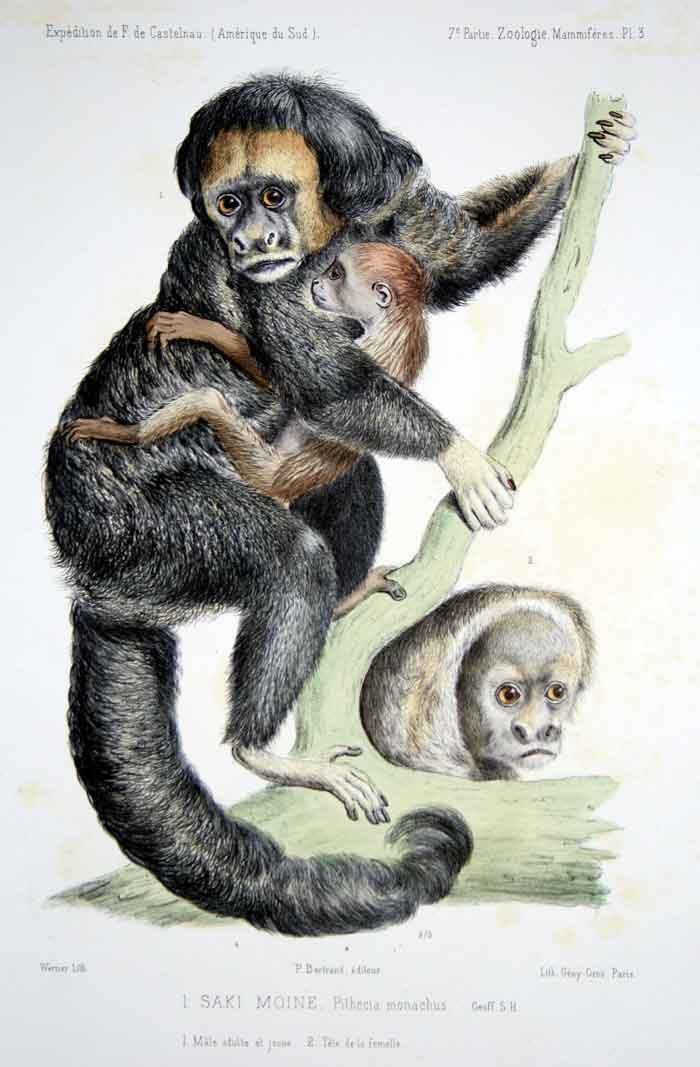
Pithecia monachus, Monk Saki, Photo: Michael Lahanas
Superregnum: Eukaryota
Cladus: Unikonta
Cladus: Opisthokonta
Cladus: Holozoa
Regnum: Animalia
Subregnum: Eumetazoa
Cladus: Bilateria
Cladus: Nephrozoa
Superphylum: Deuterostomia
Phylum: Chordata
Subphylum: Vertebrata
Infraphylum: Gnathostomata
Megaclassis: Osteichthyes
Cladus: Sarcopterygii
Cladus: Rhipidistia
Cladus: Tetrapodomorpha
Cladus: Eotetrapodiformes
Cladus: Elpistostegalia
Superclassis: Tetrapoda
Cladus: Reptiliomorpha
Cladus: Amniota
Cladus: Synapsida
Cladus: Eupelycosauria
Cladus: Sphenacodontia
Cladus: Sphenacodontoidea
Cladus: Therapsida
Cladus: Theriodontia
Cladus: Cynodontia
Cladus: Eucynodontia
Cladus: Probainognathia
Cladus: Prozostrodontia
Cladus: Mammaliaformes
Classis: Mammalia
Subclassis: Trechnotheria
Infraclassis: Zatheria
Supercohors: Theria
Cohors: Eutheria
Infraclassis: Placentalia
Cladus: Boreoeutheria
Superordo: Euarchontoglires
Ordo: Primates
Subordo: Haplorhini
Infraordo: Simiiformes
Parvordo: Platyrrhini
Familia: Pitheciidae
Subfamilia: Pitheciinae
Genus: Pithecia
Species: Pithecia monachus
Name
Pithecia monachus (É. Geoffroy, 1812)
Synonyms
Simia monacha (Original name)
Pithecia guapo
Pithecia hirsuta
Pithecia inusta
Pithecia milleri
Pithecia napensis
Vernacular names
English: Monk Saki
português: Macaco-parauacu-peruano

Pithecia monachus monachus
The monk saki (Pithecia monachus) also known as Geoffroy's monk saki, is a species of saki monkey, a type of New World monkey, from South America. It is found in forested areas of northwestern Brazil and northeastern Peru.[3]
Taxonomy
The hairy saki (P. hirsuta), Miller's saki (P. milleri), Napo saki (P. napensis), and burnished saki (P. inusta) were previously considered conspecific but were split from this species in 2014. P. monachus is now known to occupy a much smaller range than it was thought to before the split.[3][4]
Distribution
This species is found in the interfluvial between the Solimoes River, lower to middle Ucayali River and lower Javary River, in northwestern Brazil and northeastern Peru.[2]
Description
This monkey can grow up to be 30 to 50 centimetres (12 to 20 in) long and weigh about 1 to 2 kilograms (2 lb 3 oz to 4 lb 7 oz), approximately the same as a large rabbit. The thick, bushy tail can be up to 25 to 55 centimetres (10 to 22 in) long. It has coarse fur, which is long and shaggy around the face and neck.[5]
Behavior
A shy, wary animal, it is totally arboreal, living high in the trees and sometimes descending to lower levels but not to the ground. It generally moves on all fours but may sometimes walk upright on a large branch and will leap across gaps. During the day, it moves in pairs or small family groups, feeding on fruits, berries, honey, some leaves, small mammals such as mice and bats, and birds. The female gives birth to 1 young per mating season with the average family size being 4.5.[5]
References
Wikispecies has information related to Pithecia monachus (Monk saki).
Groves, C. P. (2005). "Order Primates". In Wilson, D. E.; Reeder, D. M (eds.). Mammal Species of the World: A Taxonomic and Geographic Reference (3rd ed.). Johns Hopkins University Press. pp. 147–148. ISBN 978-0-8018-8221-0. OCLC 62265494.
Marsh, L.K.; Heymann, E. W.; Moura, E.; Ravetta, A. (2018). "Pithecia monachus". IUCN Red List of Threatened Species. 2018: e.T70609726A17971958. doi:10.2305/IUCN.UK.2018-2.RLTS.T70609726A17971958.en. Retrieved 4 December 2021.
Marsh, L. K. (July 2014). "A Taxonomic Revision of the Saki Monkeys, Pithecia Desmarest, 1804". Neotropical Primates. 21 (1): 1–165. doi:10.1896/044.021.0101. S2CID 86516301.
"Explore the Database". www.mammaldiversity.org. Retrieved 2021-12-04.
Poloskey, Tara (2000). "ADW: Pithecia monachus". Animal Diversity Web. Retrieved 23 January 2013.
Retrieved from "http://en.wikipedia.org/"
All text is available under the terms of the GNU Free Documentation License

